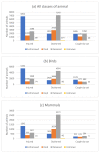Trends in Admissions and Outcomes at a British Wildlife Rehabilitation Centre over a Ten-Year Period (2012-2022)
- PMID: 38200817
- PMCID: PMC10778305
- DOI: 10.3390/ani14010086
Trends in Admissions and Outcomes at a British Wildlife Rehabilitation Centre over a Ten-Year Period (2012-2022)
Abstract
Millions of animals pass through wildlife rehabilitation centres (WRCs) globally each year, some dying in captivity, others euthanised, and some released into the wild. Those caring for these animals are generally well-intentioned, but skills, knowledge, and resources may be limited, potentially compromising animal welfare. WRC databases provide an opportunity to provide an evidence base for treatment and conservation efforts. 42,841 records of animals admitted over a 10-year period to a British WRC were analysed. More birds (69.16%) were admitted than mammals (30.48%) and reptiles and amphibians (0.36%). Most admissions were in the summer (48.8%) and spring (26.0%) months. A total of 9 of the 196 species seen made up 57% of admissions, and hedgehogs were the most common species admitted (14% of all admissions and 20% of mammals). Juvenile animals (35.5%) were admitted more frequently than 'orphans' (26.0%) or adults (26.4%). 'Orphaned' was also the predominant reason for admission (28.3%), followed by 'injured' (25.5%). 42.6% of animals were eventually released back to the wild, 19.2% died in captivity, and 37.2% were euthanised; 1% of outcomes were unknown. The prognosis was better for orphaned animals than for those admitted because of injury. Unexpected natural deaths in captivity were found to decline over the period of study, consistent with improved early triage. These findings can be used to focus veterinary and WRC training and seasonal resources on the species and case types most likely to be successfully rehabilitated and released. The findings also have the potential to contribute to our understanding of anthropogenic impacts, historical and regional variations in ecosystem health, and resultant implications for animal welfare.
Keywords: hedgehog; rehabilitation; rescue; triage; welfare; wildlife.
Conflict of interest statement
The authors have read the journal’s policy and have the following competing interests: the author (E.M.) is employee of Capital Veterinary Services Ltd. The other author has no competing interests.
Figures









Similar articles
-
The impact of human activities on Australian wildlife.PLoS One. 2019 Jan 23;14(1):e0206958. doi: 10.1371/journal.pone.0206958. eCollection 2019. PLoS One. 2019. PMID: 30673712 Free PMC article.
-
Trends in wildlife rehabilitation rescues and animal fate across a six-year period in New South Wales, Australia.PLoS One. 2021 Sep 10;16(9):e0257209. doi: 10.1371/journal.pone.0257209. eCollection 2021. PLoS One. 2021. PMID: 34506558 Free PMC article.
-
Causes, temporal trends, and the effects of urbanization on admissions of wild raptors to rehabilitation centers in England and Wales.Ecol Evol. 2022 Apr 20;12(4):e8856. doi: 10.1002/ece3.8856. eCollection 2022 Apr. Ecol Evol. 2022. PMID: 35475189 Free PMC article.
-
Veterinary treatment and rehabilitation of indigenous wildlife.J Small Anim Pract. 2014 Jun;55(6):293-300. doi: 10.1111/jsap.12213. Epub 2014 Apr 12. J Small Anim Pract. 2014. PMID: 24725160 Review.
-
A retrospective study of native wild birds and reptiles admitted to three New Zealand wildlife hospitals due to predation by cats.N Z Vet J. 2023 Mar;71(2):86-91. doi: 10.1080/00480169.2022.2152889. Epub 2023 Jan 9. N Z Vet J. 2023. PMID: 36444508 Review.
Cited by
-
Myiasis in European hedgehogs (Erinaceus europaeus).Vet Q. 2025 Dec;45(1):15-24. doi: 10.1080/01652176.2025.2463328. Epub 2025 Feb 10. Vet Q. 2025. PMID: 39927565 Free PMC article.
-
A LEAP Forward in Wildlife Conservation: A Standardized Framework to Determine Mortality Causes in Large GPS-Tagged Birds.Ecol Evol. 2025 Mar 27;15(4):e70975. doi: 10.1002/ece3.70975. eCollection 2025 Apr. Ecol Evol. 2025. PMID: 40170813 Free PMC article.
-
Fine Scale Phylogeography of Urban Western European Hedgehog Erinaceus europaeus in South-East England.Ecol Evol. 2025 Jul 17;15(7):e71729. doi: 10.1002/ece3.71729. eCollection 2025 Jul. Ecol Evol. 2025. PMID: 40686524 Free PMC article.
-
Reasons for admission and rehabilitation rates of various wildlife species in Finland.Front Vet Sci. 2024 Oct 2;11:1455632. doi: 10.3389/fvets.2024.1455632. eCollection 2024. Front Vet Sci. 2024. PMID: 39415951 Free PMC article.
-
Parasite Screening in Wild Passerines: Enhancing Diagnostic Approaches in Wildlife Rehabilitation Centers.Animals (Basel). 2024 Dec 19;14(24):3664. doi: 10.3390/ani14243664. Animals (Basel). 2024. PMID: 39765569 Free PMC article.
References
-
- Miller E.A., editor. Minimum Standards for Wildlife Rehabilitation. 4th ed. National Wildlife Rehabilitators Association and International Wildlife Rehabilitation Council; St. Cloud, MN, USA: 2012. p. 9.
-
- Tribe A., Brown P.R. The role of wildlife rescue groups in the care and rehabilitation of Australian fauna. Hum. Dimens. Wildl. 2000;5:69–85. doi: 10.1080/10871200009359180. - DOI
-
- Englefield B., Blackman S.A., Starling M., McGreevy P.D. A Review of Australian Animal Welfare Legislation, Regulation, Codes of Practice, and Policy, and Their Influence on Stakeholders Caring for Wildlife and the Animals for Whom They Care. Animals. 2019;9:335. doi: 10.3390/ani9060335. - DOI - PMC - PubMed
Grants and funding
LinkOut - more resources
Full Text Sources

